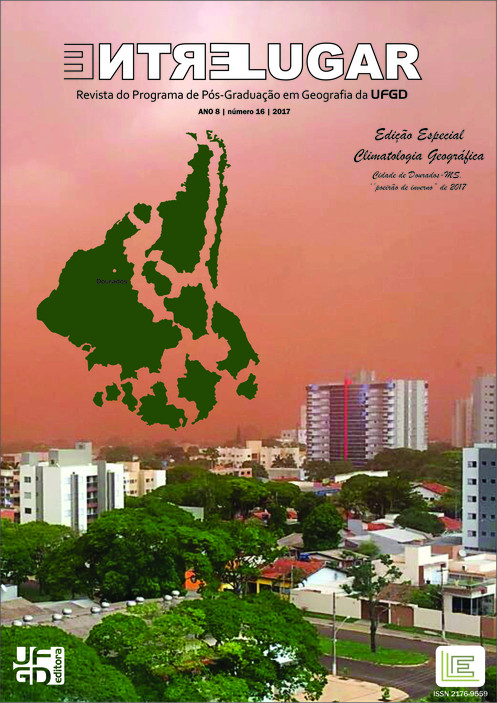Thermal comfort and different weather types in the Recife city (PE)
DOI:
https://doi.org/10.30612/el.v8i16.6269Keywords:
Urban climate. Climate rhythm. Heat island. Quantiles technique. UTI.Abstract
The present article aimed to study the urban climate of the city of Recife and its conditioners. Such as the urban structure and the atmospheric systems in progress, focusing on the space-time identification of areas of greater and lesser thermal comfort. Thereunto, it was used the method of rhythmic analysis, quantile calculations and the Temperature and Humidity Index (THI), with the month of January 2016 as a study period. Meteorological data provided by the station 82.900 of the Instituto Nacional de Meteorologia (INMET), by seventeen data stations of the Agência Pernambucana de Águas e Clima (APAC) and also by eight Data Collection Stations (DCS) were used, In addition to queries to satellite images. Finally, the ninth and twenty-ninth days were classified as "extremely rainy" and three days (16, 18 and 22) as "very rainy". THI was calculated for days 04, 09 and 22, representing the "extremely dry", "extremely rainy" and "very rainy" classes respectively. The weather systems analyzed have shown to be strong conditioners of temperature and thermal comfort in Recife, the eastern sector of the city was more uncomfortable than the west one. The
eastern sector of the city, besides being more uncomfortable, was less humid and less rainy than the western sector. It is still unknown if this pattern repeats in other month or if it is characteristic of the space in the city of Recife, but other studies should be developed to investigate this phenomenon.
Downloads
References
ALMEIDA JÚNIOR, N. L. Estudo de clima urbano: uma proposta metodológica. Dissertação. (Mestrado). Universidade Federal de Mato Grosso, 2005. 109 p.
AMORIM, M. C. C. T. Clima urbano: Estrutura térmica e ilhas de calor. In: AMORIM, M. C. T. et al. (Orgs..). Climatologia urbana e regional: questões teóricas e estudos de caso. São Paulo: Outras Expressões, 2013. 274 p.
AGÊNCIA PERNAMBUCANA DE ÁGUAS E CLIMA (APAC). 2016. Monitoramento pluviométrico, 2016.Disponível em: http://www.apac.pe.gov.br/meteorologia/> Acesso em: 22 jul. 2016.
BARBIRATO, G. M.; SOUZA, L. C. L.; TORRES, S. C. Clima e Cidade: a abordagem climática como subsídios. Maceió: EdUFAL, 2007, 2007. 154 p.
BRANDÃO, A. M. p. M. O Clima Urbano na Cidade do Rio de Janeiro. In:MONTEIRO, C. A. F.; MENDONÇA, F. (Orgs.). Clima Urbano. 2. ed. Contexto,192 p. 2011.
GOMES, E. T. A. Recortes de paisagens na cidade do Recife: uma abordagem geográfica. – Recife: Fundação Joaquim Nabuco. Massangana, 2007. 356 p., il.
HOLMER, Björn; THORSSON, Sofi a.Intra-urban nocturnal cooling – a comparison of high-latitude Göteborg, Sweden and tropical Ouagadougo, Burkina Faso.In: INTERNATIONAL CONFERENCE ON URBAN CLIMATE, 20., Yokohama, Japan. 29 June-3 July 2009.
INSTITUTO BRASILEIRO DE GEOGRAFIA E ESTATÍSTICA (IBGE). Censo 2010. Disponível em:<http://censo2010.ibge.gov.br/>. Acesso em: 15 set. 2015.
INSTITUTO NACIONAL DE METEOROLOGIA (INMET) Normais climatológicas. Disponível em: http://www.inmet.gov.br/portal/index.php?r=clima/normaisClimatologicas>. Acesso em:15 set. 2015.
JOLLANDS, N.; RUTH, M. C.; BERNIER, G. The climate's long-term impact on New Zealand infrastructure (CLINZI) Project A- case study of Hamilton City, New Zealand. Journal of Environmental Management, v. 83, Issue 4, pp. 460-477, 2007.
MENDONÇA, F.; DANNI-OLIVEIRA, I. M. Climatologia: noções básicas e climas do Brasil. São Paulo: Ofi cina de Textos, 2007. 206 p.
MONTEIRO, C. A. de F. Análise Rítmica em Climatologia: problemas da atualidade climática em São Paulo e achegas para um programa de trabalho. São Paulo: Universidade de São Paulo/Instituto de Geografia, 1971. 21 p. (Série Climatologia n. 1).
______.; MENDONÇA, F. Clima Urbano. 2. ed. Contexto, 2011. 192 p.
NÓBREGA, Ranyére Silva; LEMOS, Thiago Verçosa da Silva. O microclima e o (des) conforto térmico em ambientes abertos na cidade do Recife. Revista de Geografia (UFPE), v. 28, n. 1, 2011.
OFFERLE, B. et al. Intraurban diferrences of surface energy fluxes in a central european city. Journal of Applied Meteorology and Climatology, v. 45, pp.125-136, 2006.
OGASHAWARA, Igor.Análise rítmica e a climatologia geográfica Brasileira. Revista Eletrônica Geoaraguaia, Barra do Garças (MT), v.2, n. 2, pp. 57-72, 2012.
TAHA, H. Urban climates and heat islands: albedo, evapotranspiration, and anthropogenicheat. Energy and Buildings, n. 25, pp. 99-103, 1997.
XAVIER, T.M.B.S. A Técnica dos quantis e suas aplicações em Meteorologia, Climatologia e Hidrologia, com ênfase para as regiões brasileiras. Brasília: Th esaurus, 2002. 143p.
Downloads
Published
How to Cite
Issue
Section
License
Autores que publicam nesta revista concordam com os seguintes termos:
- Autores mantém os direitos autorais e concedem à revista o direito de primeira publicação, com o trabalho simultaneamente licenciado sob a Creative Commons Atribuição-NãoComercial-CompartilhaIgual 3.0 Brasil que permitindo o compartilhamento do trabalho com reconhecimento da autoria do trabalho e publicação inicial nesta revista.
- Autores têm autorização para assumir contratos adicionais separadamente, para distribuição não-exclusiva da versão do trabalho publicada nesta revista (ex.: publicar em repositório institucional ou como capítulo de livro), com reconhecimento de autoria e publicação inicial nesta revista.
- Autores têm permissão e são estimulados a publicar e distribuir seu trabalho online (ex.: em repositórios institucionais ou na sua página pessoal) a qualquer ponto antes ou durante o processo editorial, já que isso pode gerar alterações produtivas, bem como aumentar o impacto e a citação do trabalho publicado (Veja O Efeito do Acesso Livre).




